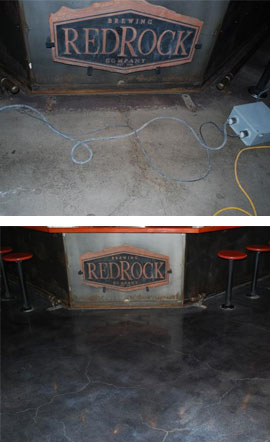Stewart Specialty Services
Concrete Polishing
Concrete polishing transforms ordinary concrete into a beautiful, durable, easy-to-clean surface. For both industrial and residential applications, polished concrete is the newest, most innovative flooring available today. Learn more about polished concrete.

Industrial Concrete Flooring
For industrial applications, polished concrete is long lasting, cost effective, and virtually maintenance free. From warehouses, schools, and restaurants to manufacturing facilities, automotive shops, and showroom floors, polished concrete ideal for the needs of any business.
See how concrete polishing compares to other types of flooring.
Residential Concrete Flooring
At home, polished concrete is a durable, efficient floor surface that eliminates the need for carpet, wood, tile, or other flooring materials that require replacement, maintenance, and harsh cleaning chemicals. Natural concrete floors provide long-lasting beauty and ease of maintenance-plus additional environmental benefits.
Learn more about the benefits of polished concrete flooring.
Understanding Polished Concrete
Concrete polishing has been in use for a slightly more than a decade. It was first used in warehouses to eliminate dusting, increase lighting, reduce ware on equipment, and to create a permanent, low maintenance, coating-free flooring solution. Advances in concrete polishing technology have allowed contractors the ability to add color, decorative saw cuts, and specialty aggregate that later gets exposed by grinding. As a result of these advances, the process of polishing is now being promoted as a flooring solution to other markets such as retail, restaurants, schools, office buildings, and residential homes. The end result is a functional astatically pleasing flooring solution.
Polished concrete starts with the processing of the concrete surface, the act of changing an existing concrete surface by means of a mechanical process that involves cutting and/or refining the surface to a desired finish. Polished concrete is one of many end results in the processing of the concrete surface by mechanical refinement through the use of multiple abrasives that are measured in grits (much like sand paper for woodworking). Grits are applied from roughest to finest and each girt density refines the concrete surface in preparation for the ultimate surface finish desired. When processing concrete to a achieve a fully polished finish, one that has clarity of reflection and durability, a contractor will use six to nine different grits depending on many factors. During the process, a densifier is applied that creates a crystalline structure within the pores of the concrete to make it denser, thereby increasing the concrete stain resistance. The densifier also fills in micro surface imperfections, making the surface more uniform and helping attain clarity of reflection and durability.
The many benefits to industrial polished concrete flooring include:
- Low to no maintenance
- High durability
- Eliminates dusting and tire marks
- Fire resistant
- Low installation and maintenance costs
- Environmentally friendly
